Transient Heat Transfer Between Two Horizontal Pipelines in a Heat Tracing Enclosure
Abstract
:1. Introduction
2. Problem Definition and Modeling
2.1. Mathematical Formulation
2.2. Numerical Method
3. Results and Discussion
3.1. Case of Ra = 1 × 104 and s/d = 0.7
3.2. Case of Ra = 1 × 105 and s/d = 0.7
3.3. Case of Ra = 1 × 104 and s/d = 0.8333
3.4. Comparison of Different Cases
4. Conclusions
- (1)
- When the cylinders are positioned vertically (ϕg (inclination angle of the enclosure) = –90°; with the cold cylinder above the hot cylinder) and the Rayleigh (Ra) number is small, the flow field varies significantly during development due to the buoyancy effect; however, the flow field eventually reaches a steady state. The maximum Ra number that reaches a steady state is lower than that when the cylinders are positioned horizontally (ϕg = 0°).
- (2)
- When the cylinders are positioned vertically (ϕg = –90°), as heat flow from the hot cylinder moves upward and the cold flow from the cold cylinder moves downward, the temperature distribution and flow field are distorted. However, when the strengths of the two flows are close in value, symmetry can be maintained.
- (3)
- When the cylinders are positioned vertically (ϕg = –90°), transient fluctuations in the flow field and heat transfer occur as the Ra number increases or the distance between cylinders decreases.
- (4)
- Compared with horizontally positioned cylinders (ϕg = 0°), vertically positioned cylinders (ϕg = –90°) are more likely to feature chaotic flow field and heat transfer patterns. Similarly, a center-to-center half-spacing of 0.7 between cylinders is less stable than that of 0.8333.
- (5)
- Under the current investigated conditions, increasing the Ra number significantly increases the average heat transfer between cold and hot cylinders.
Author Contributions
Funding
Conflicts of Interest
Nomenclature
| a1, a2, a3 | Geometric coefficients |
| c | Specific heat (J/kg K) |
| d | Diameter of cylinder (m) |
| Fo | Fourier number (αt/d2) |
| g | Gravitational acceleration (m/s2) |
| h | Heat transfer coefficient (W/m2 K) |
| J | Jacobian |
| k | Thermal conductivity coefficient (W/m K) |
| Nu | Nusselt number |
| Average Nusselt number () | |
| P | Coordinate control function |
| Pr | Prandtl number () |
| Q | Coordinate control function |
| r+ | Radial coordinate (m) |
| r | Dimensionless radial coordinate (r+/d) |
| Ra | Rayleigh number (g(Th – Tc)d3/) |
| Ri | Radius of cylinder (d/2) |
| Ro | Radius of circular enclosure |
| s | Center-to-center half spacing between cylinders |
| t | Time (s) |
| T | Temperature |
| Tm | Mean temperature ((Th + Tc)/2)) |
| Overall heat transfer coefficient | |
| U, V | Contravariant velocity components |
| Greek symbols | |
| Thermal diffusivity (k/c) (m2/s) | |
| Thermal expansion coefficient (1/K) | |
| Thickness (m) | |
| η | Transformed coordinate |
| Dimensionless temperature ((T – Tm)/(Th – Tc)) | |
| ν | Kinematic viscosity (m2/s) |
| Density (kg/m3) | |
| ξ | Transformed coordinate |
| ϕ | Angular coordinate |
| Φ | Angular location on cylinder surface |
| ϕg | Inclination angle |
| Dimensionless stream function | |
| Dimensionless vorticity | |
| Subscripts | |
| c | Cold cylinder |
| h | Hot cylinder |
| m | Mean value |
| o | Circular enclosure |
References
- Kassai, M. Experimental investigation on the effectiveness of sorption energy recovery wheel in ventilation system. Exp. Heat. Transfer 2017, 32, 106–120. [Google Scholar] [CrossRef]
- Kassai, M. Investigation of carbon dioxide cross-contamination in sorption energy recovery wheel in ventilation system. Build. Serv. Eng. Res. Trans. 2018, 39, 463–474. [Google Scholar] [CrossRef]
- Kassai, M.; Simonson, C.J. Experimental effectiveness investigation of liquid-to-air membrane energy exchangers under low heat capacity rates conditions. Exp. Heat. Transf. 2016, 29, 445–455. [Google Scholar] [CrossRef]
- Kohli, I.P. Steam tracing of pipelines. Chem. Eng. J. 1979, 86, 156–163. [Google Scholar]
- Kassai, M. Effectiveness and humidification capacity investigation of liquid-to-air membrane energy exchanger under low heat capacity ratios at winter air conditions. J. Therm. Sci. 2015, 24, 391–397. [Google Scholar] [CrossRef]
- Kassai, M.; Simonson, C.J. Performance investigation of liquid-to-air membrane energy exchanger under low solution/air heat capacity rates ratio conditions. Build. Serv. Eng. Res. Trans. 2015, 36, 535–545. [Google Scholar] [CrossRef]
- Baïri, A.; Zarco-Pernia, E.; de María, J.M.G. A review on natural convection in enclosures for engineering applications. The particular case of the parallelogrammic diode cavity. Appl. Therm. Eng. 2014, 63, 304–322. [Google Scholar] [CrossRef]
- Ho, C.J.; Chang, W.S.; Wang, C.C. Natural convection between two horizontal cylinders in an adiabatic circular enclosure. J. Heat Transf. 1993, 115, 158–165. [Google Scholar] [CrossRef]
- Ho, C.J.; Cheng, Y.T.; Wang, C.C. Natural convection between two horizontal cylinders inside a circular enclosure subjected to external convection. Int. J. Heat Fluid Flow 1994, 15, 299–306. [Google Scholar] [CrossRef]
- Wang, Q.X.; Lei, H.Y.; Wang, S.X.; Dai, C.S. Natural convection around a pair of hot and cold horizontal microtubes at low Rayleigh numbers. Appl. Therm. Eng. 2014, 72, 114–119. [Google Scholar] [CrossRef]
- Dai, C.S.; Li, M.; Lei, H.Y.; Wang, S.X. Numerical simulation of natural convection between hot and cold microtubes in a cylinder enclosure. Int. J. Therm. Sci. 2015, 95, 115–122. [Google Scholar] [CrossRef]
- Khalili, E.; Saboonchi, A.; Saghafian, M. Natural convection of Al2O3 nanofluid between two horizontal cylinders inside a circular enclosure. Heat Transf. Eng. 2017, 38, 177–189. [Google Scholar] [CrossRef]
- Ho, C.J.; Sou, G.N.; Lai, C.M. Effects of a flow mode transition on natural convection heat transfer in a heat tracing enclosure. Proc. Inst. Mech. Eng. E J. Process Mech. Eng. 2018. [Google Scholar] [CrossRef]
- Ho, C.J.; Tu, F.J. Numerical study on oscillatory convection of cold water in a tall vertical enclosure. Int. J. Numer. Method Heat Fluid Flow 1999, 9, 487–508. [Google Scholar] [CrossRef]
- Thompson, J.F.; Thames, F.C.; Mastin, C.W. Automatic numerical generation of body-fitted curvilinear coordinate system for field containing any number of arbitrary two-dimensional bodies. J. Comput. Phys. 1974, 15, 299–319. [Google Scholar] [CrossRef]
- Thomas, P.D.; Middlecoff, J.F. Direct control of the grid point distribution in meshes generated by elliptic equations. AIAA J. 1980, 18, 652–656. [Google Scholar] [CrossRef]
- Adlam, J.H. Computation of two-dimensional time-dependent natural convection in a cavity where there are internal bodies. Comput. Fluids 1986, 14, 141–157. [Google Scholar] [CrossRef]
- Park, S.K.; Chang, K.S. Numerical study on interactive laminar natural convection from a pair of vertically separated horizontal cylinders. Numer. Heat Transf. 1988, 14, 61–74. [Google Scholar] [CrossRef]

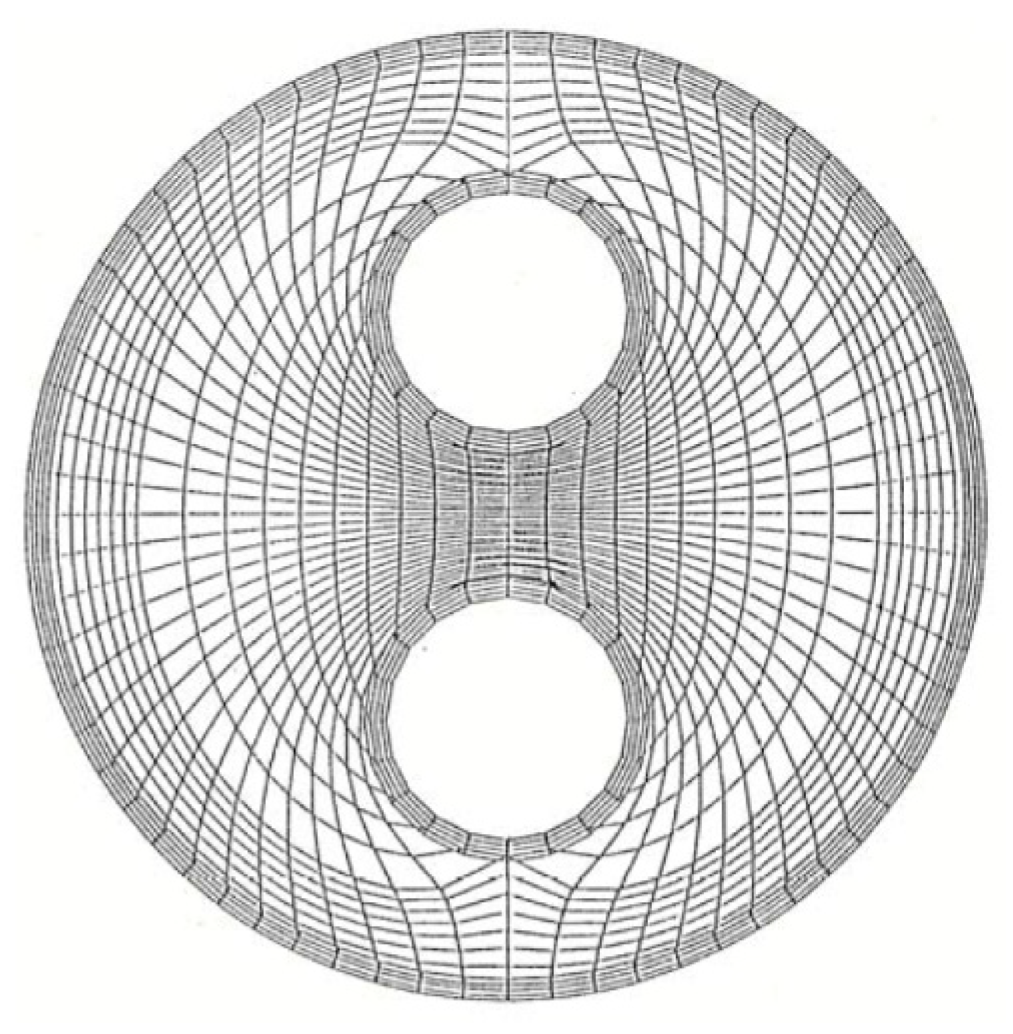
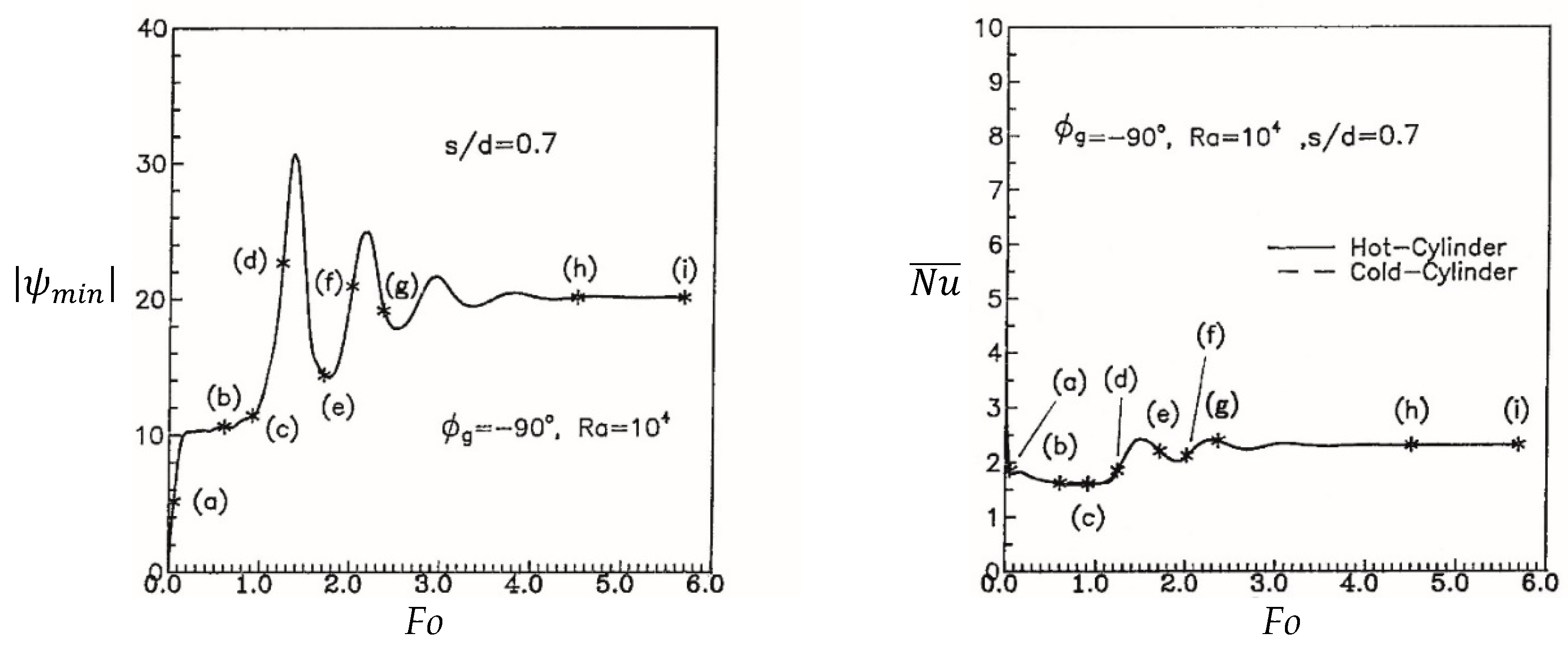



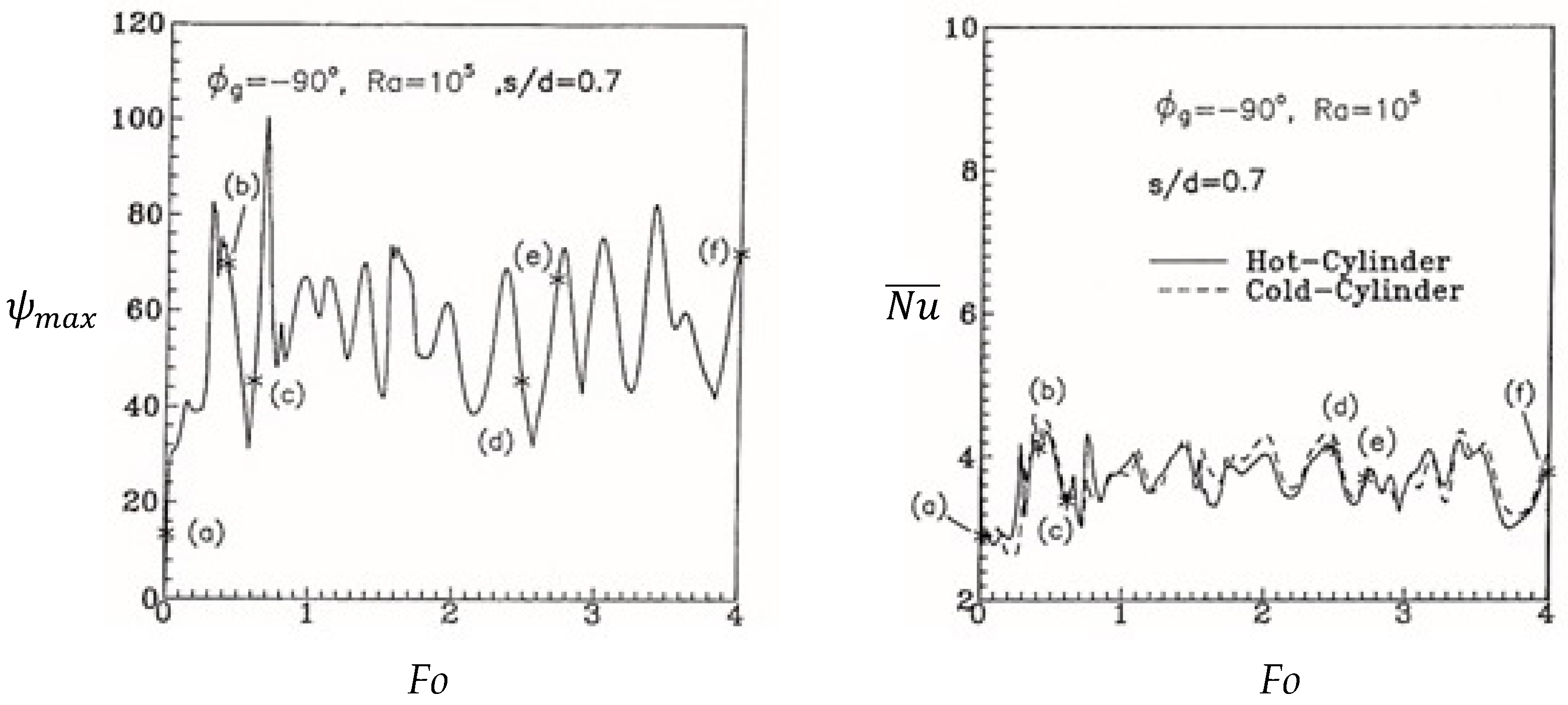


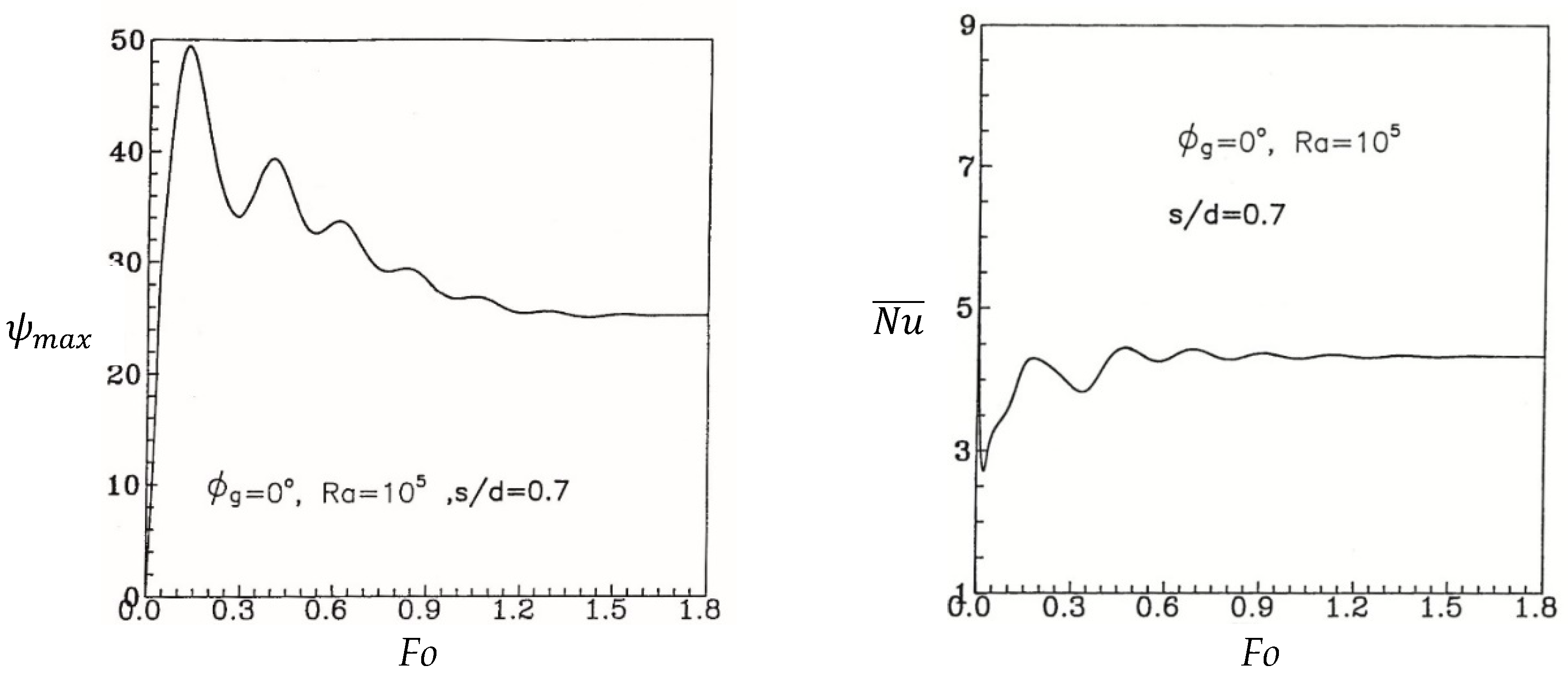
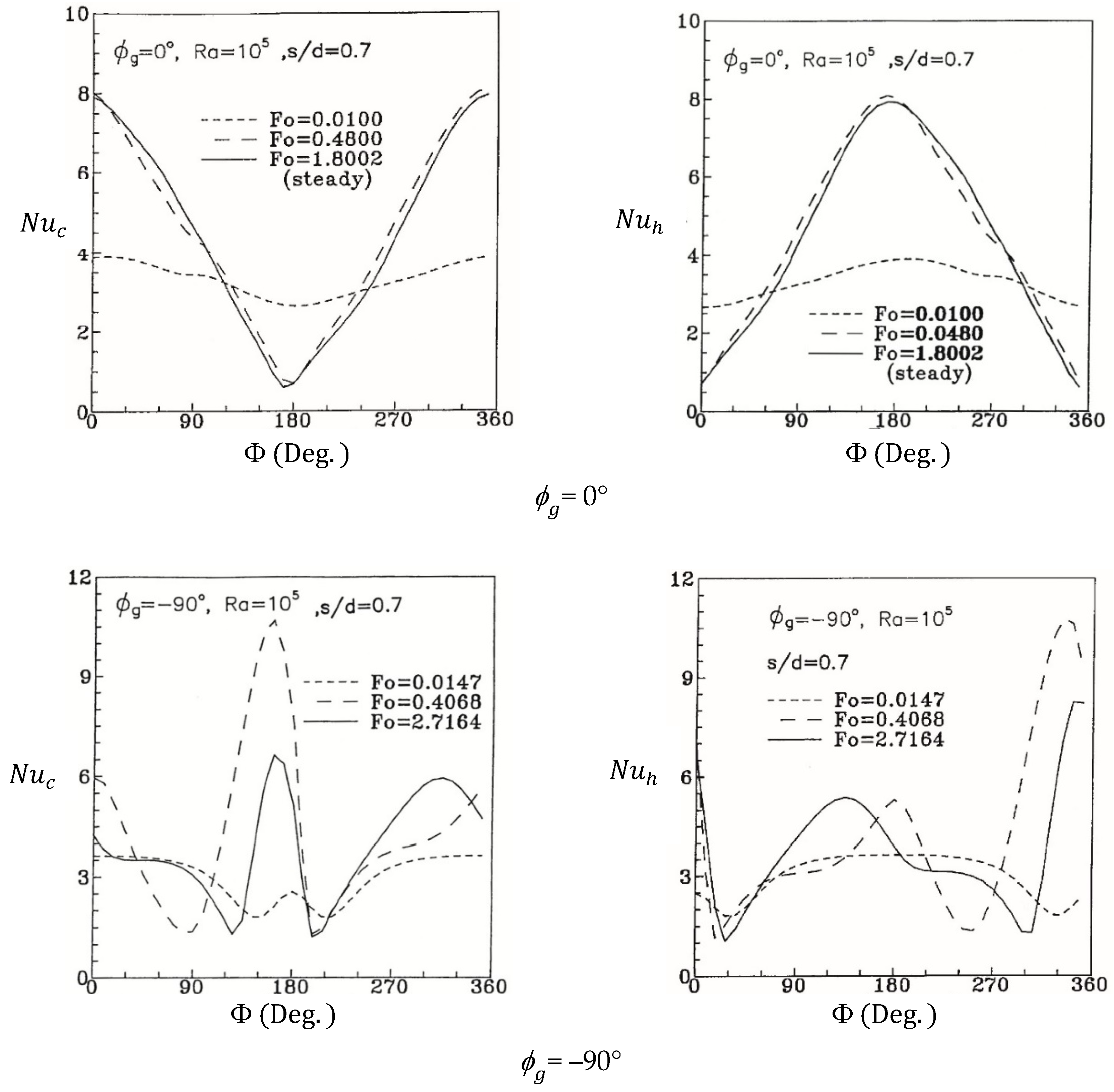
© 2019 by the authors. Licensee MDPI, Basel, Switzerland. This article is an open access article distributed under the terms and conditions of the Creative Commons Attribution (CC BY) license (http://creativecommons.org/licenses/by/4.0/).
Share and Cite
Ho, C.J.; Sou, G.N.; Lai, C.-M. Transient Heat Transfer Between Two Horizontal Pipelines in a Heat Tracing Enclosure. Energies 2019, 12, 1440. https://doi.org/10.3390/en12081440
Ho CJ, Sou GN, Lai C-M. Transient Heat Transfer Between Two Horizontal Pipelines in a Heat Tracing Enclosure. Energies. 2019; 12(8):1440. https://doi.org/10.3390/en12081440
Chicago/Turabian StyleHo, C.J., G.N. Sou, and Chi-Ming Lai. 2019. "Transient Heat Transfer Between Two Horizontal Pipelines in a Heat Tracing Enclosure" Energies 12, no. 8: 1440. https://doi.org/10.3390/en12081440
APA StyleHo, C. J., Sou, G. N., & Lai, C.-M. (2019). Transient Heat Transfer Between Two Horizontal Pipelines in a Heat Tracing Enclosure. Energies, 12(8), 1440. https://doi.org/10.3390/en12081440





